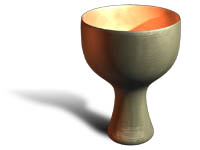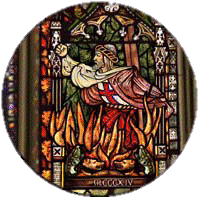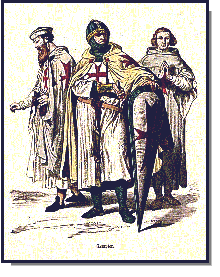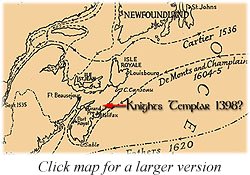
For nearly two millennia, the western world has been faced with a mystery that many have tried to solve, but none have been successful as of yet. Namely, what happened to the Holy Grail? The legendary chalice reputed to have
To explain the theory, we first must go back almost two thousand years to the period shortly after the death of Christ. It is said that
Meanwhile, half a continent away in Israel, an order of Knights was forming around a treasure dating back almost three thousand years. The Knights Templar, as they became known, were formed to safeguard this treasure which is believed to have consisted of gold, silver, and several religious artifacts. Among these were the Ark of the Covenant (the box which is said to have held the Ten Commandments), the Shroud of Turin, and the Holy Grail itself (although how they came into possession of it, sometime around the eleventh century AD, is unknown).
The Order of the Knights Templar was originally named Order of Poor Knights of the Temple of Solomon. In the beginning they were made up primarily of French soldiers who, shortly after Jerusalem was attacked in 1099, decided to protect pilgrims on the dangerous journey between Jaffa (in Palestine) and Jerusalem. Later on, this volunteer force became used as a sort of primitive religious version of community service; noblemen would be offered remission from their sins by the church in return for providing the pilgrims with protection.
Although it is not know exactly how they did this, the Knights Templar eventually managed to amass great wealth, becoming one of the richest and most powerful groups in Europe. They had "branches" throughout most of the European continent and by the
In 1308, Phillip of France issued an order to destroy the Templars and seize their wealth. Raids of their strongholds were made and around a hundred of them were tried and executed, but their legendary treasure was nowhere to be found. Many believe that
the surviving Knights Templar took the treasure to Scotland, where they were welcomed and given refuge by Robert the Bruce. It's believed that they remained safe there for a while, fighting alongside the Bruce, but this sanctuary was short-lived and ended with the threat of imminent English invasion.
At that time in Scotland, there existed one Lord Henry Sinclair Lord of Rosslyn. Lord Henry was a close friend of Robert the Bruce and the Sinclairs had long been connected to the Templars. In fact, there were quite a few Sinclairs who were members. Henry controlled a large fleet of ships, the command of which he gave to Carlo Zeno, the 'The Lion of Venice', who was considered by many to be the greatest admiral of the time. While exploring for Sinclair, who wanted to build a large empire, Zeno traveled farther and farther west and it is believed by some that he even made it as far as Nova Scotia (at that time called
On April 1 1397, Sinclair's fleet of 13 small ships set sail. It's believed that they reached Nova Scotia sometime in May or June and were quite enthralled by the new land they had "discovered". Sinclair, two small ships, and several of his men remained behind in Nova Scotia to setup a base and explore, while the rest of his men returned home to Scotland. It's said that Sinclair and party befriended the Micmac Indians who inhabited Nova Scotia and discovered two islands at the mouth of the Gold and Gapreau rivers, both of which they named Oak Island (because they were the only two islands in Nova Scotia on which Oak trees would grow). According to the story, Sinclair and his party may have built a castle on the peninsula between the two rivers.
They stayed there for nearly a year, using the time to explore and build a larger ship. With it, they left Nova Scotia and traveled along the coast to modern day Westford, Massachusetts, where they are said to have again had good relations with the local natives. Eventually they returned home to Scotland, where Sinclair lived until 1401. It is thought by many that Sinclair may have left several people, possibly members of the Knights Templar, in Nova Scotia to form a colony. Some also believe that this
voyage had purposes other than just exploration, that Sinclair may have transported several of the Templars and some of their treasure to Nova Scotia where it was buried on Oak Island for safekeeping. The favored theory is that one of the items taken to Nova Scotia was no less than the Grail itself.
While this story might sound far-fetched, there is evidence that supports it, or at least parts of it. One of the most compelling is the maps made by Zeno of the area, which have been dated as coming from the late 14th century and are surprisingly accurate.
The legend of the Oak Island treasure has been around a long time in Nova Scotia and every year it attracts many treasure hunters hoping to find it. The legend first became widely known a little over ten years ago when Canadian Michael Bradley published the book Holy Grail Across the Atlantic. The theories put forth by Bradley have their share of detractors and supporters, but since no one has found any definite proof either way (such as the treasure itself), we may never know. However, the Vikings' trips to North America preceded Columbus by several centuries, so it isn't that hard to believe Sinclair's fleet reached Nova Scotia a mere hundred years before Columbus.
SBB, November, 1999
Special thanks to the Clan Sinclair Society of Nova Scotia for permission to use the photograph of Prince Henry Sinclair's memorial at Boylston Park, Guysborough, Nova Scotia.
Links:
Michael Bradley's book, Holy Grail Across the Atlantic, reviewed.
History of the Knights Templar.
Time line of Scottish Knights Templar History.
Time line of the Holy Grail.
|
Thursday, December 26th, 2019
Attention visitors: Tartans.com is back. Please note that this is a snapshot of the site as it existed nearly 20 years ago and you may encounter broken links; we are still combing through the site and correcting those as we find them. Please also note that some sections are currently not functional, primarily the discussion forums/clan chat boards.
|
** HOME - First Time Visitors - Glossary - - Contact Us ** Awards | Bibliography | Clan Calendar | Clan Chat | Clan Finder | History | Famous Scots | Genealogy | Great Hall of the Clans | Links | News and Features | Scots on the Net | Search | Site Map The Gathering of the Clans
Copyright 1995- Tartans.com - All Rights Reserved. |
 been used by Christ at the Last Supper (and later filled with his blood) has had its whereabouts speculated and rumored about since the first century AD. But there haven't really been any leads that have gone beyond rumor and speculation. Until fairly recently at least. In this century, a new theory has been put forth, a theory that states that the Grail is buried somewhere in Nova Scotia, Canada. While this might sound incredible and far-fetched, there is a surprising amount of evidence to support it. And even if it is fiction, it's still entertaining, with a secret order of Knights and a possible voyage to North America which is believed to have occurred nearly a hundred years before Columbus first "sailed the ocean blue."
been used by Christ at the Last Supper (and later filled with his blood) has had its whereabouts speculated and rumored about since the first century AD. But there haven't really been any leads that have gone beyond rumor and speculation. Until fairly recently at least. In this century, a new theory has been put forth, a theory that states that the Grail is buried somewhere in Nova Scotia, Canada. While this might sound incredible and far-fetched, there is a surprising amount of evidence to support it. And even if it is fiction, it's still entertaining, with a secret order of Knights and a possible voyage to North America which is believed to have occurred nearly a hundred years before Columbus first "sailed the ocean blue."
 Joseph of Arimathea was given the cup that Christ drank from during the Last Supper and that he, before burying him, used it to collect his blood. According to the story, he then took it to what would later become Great Britain, where it was passed down through his family for the next several hundred years.
Joseph of Arimathea was given the cup that Christ drank from during the Last Supper and that he, before burying him, used it to collect his blood. According to the story, he then took it to what would later become Great Britain, where it was passed down through his family for the next several hundred years.
 1300's they were also the largest moneylenders; many of the nobility and royalty of the European nations owed them large amounts of money. Because of this, they were resented (and hated) for their wealth and power by many of those who were in debt to them, and this lead to their eventual downfall.
1300's they were also the largest moneylenders; many of the nobility and royalty of the European nations owed them large amounts of money. Because of this, they were resented (and hated) for their wealth and power by many of those who were in debt to them, and this lead to their eventual downfall.

